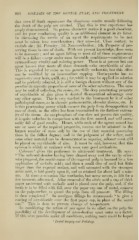Page 886 - My FlipBook
P. 886
890 DISEASES OF THE DENTAL PULP, AND TREATMENT. :
that even if death supervenes the disastrous results usually following
the death of the pulp are averted. That this is true experience has
amply demonstrated. Its jjorous character makes it a good absorbent,
and its poor conducting quality is an additional element in its favor.
In discussing the merits of an agent the requirements to be met
must be taken into consideration ; they are— 1st. Close contact, to
exclude air ; 2d. Porosity ; 3d. Non-conduction ; 4th. Property of pre-
serving tissue in case of death. AVith our present knowledge, these seem
to be necessarv ; and an agent foiling to meet all of these requirements
Mill be a failure except under most favorable conditions—conditions of
extraordinary vitality and resisting power. There is at present but one
airent known that meets all these demands—the oxychloride of zinc.
This is regarded by some as too powerfidly escharotic, but this eifect
can be modified by an intermediate capping. Gutta-percha has no
superiority over horn, quill, etc. ; for,Mhile it may be applied in solution
and be perfectly adapted, it is still a foreign element without any of the
peculiar therapeutic properties of some of the other substances. The same
may be said of collodion, the resins, etc. The deep-penetrating property
of oxychloride of zinc gives it decided therapeutical advantage over
anv other agent. This is very marked in the treatment by it of other
pathological states, as in chronic pericementitis, alveolar abscess, etc. It
is this penetrating power which ensures the pulp from decomposition in
case of death, as the effect has been transmitted to the farthest extrem-
ity of the tissue. As oxyphosphate of zinc does not possess this quality,
it is quite valueless in comparison with the first named, and will neces-
sarily fail of good results. Hence, while each of the agents named has
one or more of the required properties, success can be attained in the
largest number of cases only by the use of that material possessing
these in the fullest degree ; and in the judgment of the writer, until
some other material can be demonstrated as superior, reliance must still
be placed on oxychloride of zinc. It must be said, however, that this
opinion is Avidely at variance with some very good authorities.
Coleman ' gives the preference to nitric-acid treatment. He says
" The softened dentine having been cleared away and the cavity other-
wise prepared, the sensitiveness of the exposed pulp is lessened by a free
a])j>lication of carbolic acid ; and then a small disc of card but little
larger than the exposed surface, and well saturated with the strongest
nitric acid, is laid gently upon it, and so retained for about half a min-
ute. At times a sensation like toothache, but never severe, is felt for a
few moments afterward. After removal of the nitric acid a cap of thick
])aper moistened with carbolic acid is placed over the pulp, and, if the
tooth is to be filled with foil, over the paper cap one of metal, concave
on the pulp-surface, to guard the pulp from all pressure. The filling
is then completed." In amalgam fillings he recommends " to give a
coating of oxychloride over the first jiaper cap, in place of the metal
one." Tliis is done to prevent change of temperature.
In considering the action of any agent in its eifect on the pulp the
]>ossibility of the development of osteo-dentine must enter as a factor.
If this were possible under all conditions, nothing more could be hoped
' Dental Surgery and Pathology.


